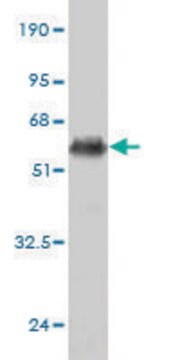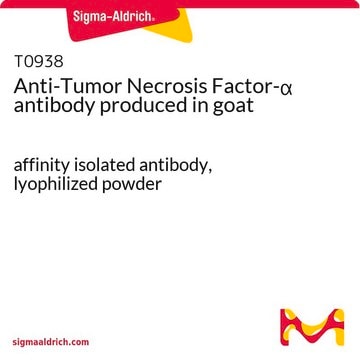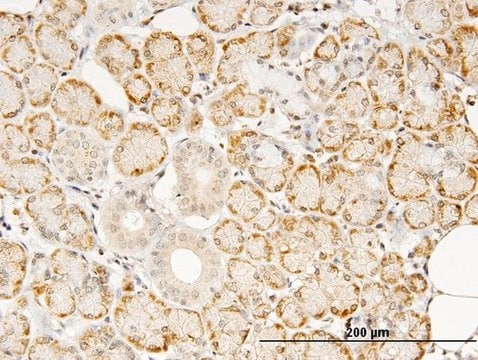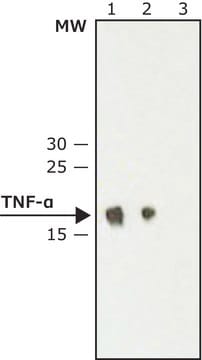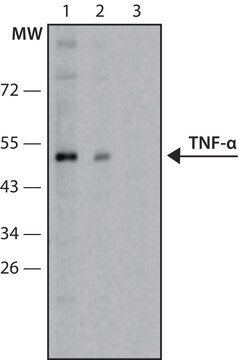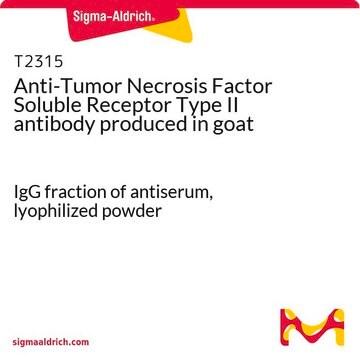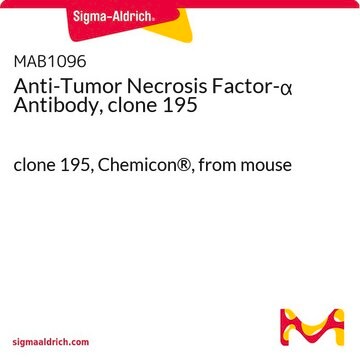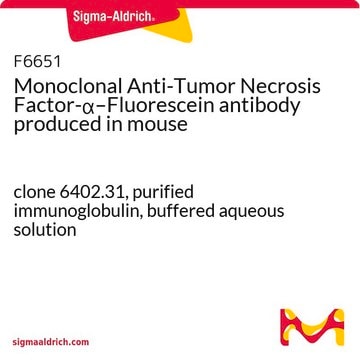T3198
Monoclonal Anti-Tumor Necrosis Factor-α antibody produced in mouse
clone 45418.111, purified immunoglobulin, lyophilized powder
Sinonimo/i:
Anti-TNF-α
About This Item
Prodotti consigliati
Origine biologica
mouse
Livello qualitativo
Coniugato
unconjugated
Forma dell’anticorpo
purified immunoglobulin
Tipo di anticorpo
primary antibodies
Clone
45418.111, monoclonal
Forma fisica
lyophilized powder
Reattività contro le specie
rat
tecniche
capture ELISA: suitable
neutralization: suitable
western blot: 1-2 μg/mL
Isotipo
IgG1
N° accesso UniProt
Temperatura di conservazione
−20°C
modifica post-traduzionali bersaglio
unmodified
Informazioni sul gene
rat ... Tnf(24835)
Descrizione generale
Immunogeno
Applicazioni
Azioni biochim/fisiol
Tumor necrosis factor-α (TNFα) affects various cellular processes such as blood-brain barrier, inflammatory, thrombogenic and vascular changes following brain damage. TNFα expression is upregulated in various central nervous system disorders, including Alzheimer′s disease, multiple sclerosis, Parkinson′s disease, meningococcal meningitis and human immunodeficiency virus (HIV) infection. Elevated expression of TNFα in the brain and blood in response to lipopolysaccharide might increase brain stem thrombosis, hemorrhage and stroke sensitivity/risk in hypertensive rats. Tumor necrosis factor-α activates polymorphonuclear leukocyte NADPH oxidase, thereby facilitates development of systemic oxidative stress (OS), inflammation and hypertension in rats.
Stato fisico
Esclusione di responsabilità
Non trovi il prodotto giusto?
Prova il nostro Motore di ricerca dei prodotti.
Codice della classe di stoccaggio
11 - Combustible Solids
Classe di pericolosità dell'acqua (WGK)
WGK 3
Punto d’infiammabilità (°F)
Not applicable
Punto d’infiammabilità (°C)
Not applicable
Dispositivi di protezione individuale
Eyeshields, Gloves, type N95 (US)
Certificati d'analisi (COA)
Cerca il Certificati d'analisi (COA) digitando il numero di lotto/batch corrispondente. I numeri di lotto o di batch sono stampati sull'etichetta dei prodotti dopo la parola ‘Lotto’ o ‘Batch’.
Possiedi già questo prodotto?
I documenti relativi ai prodotti acquistati recentemente sono disponibili nell’Archivio dei documenti.
Il team dei nostri ricercatori vanta grande esperienza in tutte le aree della ricerca quali Life Science, scienza dei materiali, sintesi chimica, cromatografia, discipline analitiche, ecc..
Contatta l'Assistenza Tecnica.
